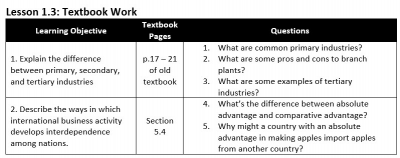Lesson 1.3 - International Interdependence
Learning Goals:
By the end of this lesson you will be able to describe the ways in which international business activity develops interdependence among nations.
Learning Activities:
1.Textbook readings2.Watch Pencil: The Movie + Answer questions3. Check your understanding-Production4.Glossary quiz5.Exit Card6.Homework forum post- Open this and read it to answer questions 1-3.
Watch the video and answer the questions before class.
With your group, discuss the mini case below. Each group will present their answers to the class.
Mini Case:
At the end of the 19th century, the invention of refrigeration enabled Argentina to supply frozen meat to the world market. Argentina’s meat exports went from 0 in 1900 to 400,000 tons a year by 1913. The US went from beef exports of 150,000 tons in 1900 to 0 by 1913.
Questions:
1. Why did beef exports in the US drop so much?2. Who gained and who lost in this early example of globalization?3. What are the primary, secondary, and tertiary industries related to beef?4. Suppose USA can make 100 thousand tons of beef or 50 thousand tons of corn, while Argentina can make 30 thousand tons of beef or 30 thousand tons of corn. How should the two countries trade? Why?Do this quiz if you finished all the work and activities and you have no questions about the lesson. If you have questions, you can message the teacher first.
Post your textbook notes for this lesson here. Today's lesson is on Section 5.4 and pages 17-21.
You copy and paste from your word document or attach the file
1: What does Canada export to other countries?
2: What are the five most common primary industries?
3: What are some pros and cons to branch plants?
4: What are some examples of tertiary industries?
5: What’s the difference between absolute advantage and comparative advantage?
6: Why might a country with an absolute advantage in making apples import apples from another country?
